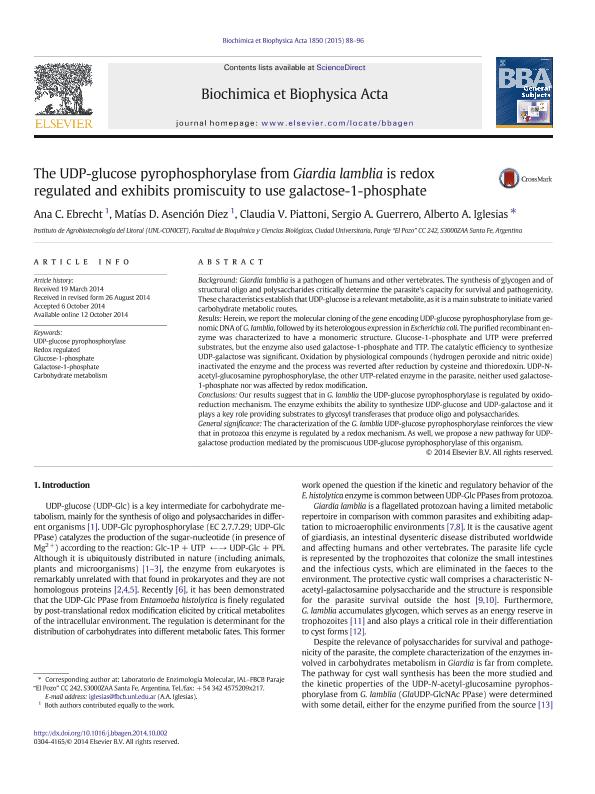Mostrar el registro sencillo del ítem
dc.contributor.author
Ebrecht, Ana Cristina

dc.contributor.author
Asención Diez, Matías Damián

dc.contributor.author
Piattoni, Claudia Vanesa

dc.contributor.author
Guerrero, Sergio Adrian

dc.contributor.author
Iglesias, Alberto Alvaro

dc.date.available
2018-03-01T21:06:59Z
dc.date.issued
2015-01
dc.identifier.citation
Ebrecht, Ana Cristina; Asención Diez, Matías Damián; Piattoni, Claudia Vanesa; Guerrero, Sergio Adrian; Iglesias, Alberto Alvaro; The UDP-glucose pyrophosphorylase from Giardia lamblia is redox regulated and exhibits promiscuity to use galactose-1-phosphate; Elsevier Science; Biochimica et Biophysica Acta- General Subjects; 1850; 1; 1-2015; 88-96
dc.identifier.issn
0304-4165
dc.identifier.uri
http://hdl.handle.net/11336/37625
dc.description.abstract
Background: Giardia lamblia is a pathogen of humans and other vertebrates. The synthesis of glycogen and of structural oligo and polysaccharides critically determine the parasite's capacity for survival and pathogenicity. These characteristics establish that UDP-glucose is a relevant metabolite, as it is a main substrate to initiate varied carbohydrate metabolic routes. Results: Herein, we report the molecular cloning of the gene encoding UDP-glucose pyrophosphorylase from genomic DNA of G. lamblia, followed by its heterologous expression in Escherichia coli. The purified recombinant enzyme was characterized to have a monomeric structure. Glucose-1-phosphate and UTP were preferred substrates, but the enzyme also used galactose-1-phosphate and TTP. The catalytic efficiency to synthesize UDP-galactose was significant. Oxidation by physiological compounds (hydrogen peroxide and nitric oxide) inactivated the enzyme and the process was reverted after reduction by cysteine and thioredoxin. UDP-N-acetyl-glucosamine pyrophosphorylase, the other UTP-related enzyme in the parasite, neither used galactose-1-phosphate nor was affected by redox modification. Conclusions: Our results suggest that in G. lamblia the UDP-glucose pyrophosphorylase is regulated by oxido-reduction mechanism. The enzyme exhibits the ability to synthesize UDP-glucose and UDP-galactose and it plays a key role providing substrates to glycosyl transferases that produce oligo and polysaccharides. General significance: The characterization of the G. lamblia UDP-glucose pyrophosphorylase reinforces the view that in protozoa this enzyme is regulated by a redox mechanism. As well, we propose a new pathway for UDP-galactose production mediated by the promiscuous UDP-glucose pyrophosphorylase of this organism.
dc.format
application/pdf
dc.language.iso
eng
dc.publisher
Elsevier Science

dc.rights
info:eu-repo/semantics/openAccess
dc.rights.uri
https://creativecommons.org/licenses/by-nc-sa/2.5/ar/
dc.subject
Carbohydrate Metabolism
dc.subject
Galactose-1-Phosphate
dc.subject
Glucose-1-Phosphate
dc.subject
Redox Regulated
dc.subject
Udp-Glucose Pyrophosphorylase
dc.subject.classification
Otras Ciencias Biológicas

dc.subject.classification
Ciencias Biológicas

dc.subject.classification
CIENCIAS NATURALES Y EXACTAS

dc.title
The UDP-glucose pyrophosphorylase from Giardia lamblia is redox regulated and exhibits promiscuity to use galactose-1-phosphate
dc.type
info:eu-repo/semantics/article
dc.type
info:ar-repo/semantics/artículo
dc.type
info:eu-repo/semantics/publishedVersion
dc.date.updated
2018-02-28T14:29:34Z
dc.journal.volume
1850
dc.journal.number
1
dc.journal.pagination
88-96
dc.journal.pais
Países Bajos

dc.journal.ciudad
Amsterdam
dc.description.fil
Fil: Ebrecht, Ana Cristina. Consejo Nacional de Investigaciones Científicas y Técnicas. Centro Científico Tecnológico Conicet - Santa Fe. Instituto de Agrobiotecnología del Litoral. Universidad Nacional del Litoral. Instituto de Agrobiotecnología del Litoral; Argentina. Universidad Nacional del Litoral. Facultad de Bioquímica y Ciencias Biológicas; Argentina
dc.description.fil
Fil: Asención Diez, Matías Damián. Consejo Nacional de Investigaciones Científicas y Técnicas. Centro Científico Tecnológico Conicet - Santa Fe. Instituto de Agrobiotecnología del Litoral. Universidad Nacional del Litoral. Instituto de Agrobiotecnología del Litoral; Argentina. Universidad Nacional del Litoral. Facultad de Bioquímica y Ciencias Biológicas; Argentina
dc.description.fil
Fil: Piattoni, Claudia Vanesa. Consejo Nacional de Investigaciones Científicas y Técnicas. Centro Científico Tecnológico Conicet - Santa Fe. Instituto de Agrobiotecnología del Litoral. Universidad Nacional del Litoral. Instituto de Agrobiotecnología del Litoral; Argentina. Universidad Nacional del Litoral. Facultad de Bioquímica y Ciencias Biológicas; Argentina
dc.description.fil
Fil: Guerrero, Sergio Adrian. Consejo Nacional de Investigaciones Científicas y Técnicas. Centro Científico Tecnológico Conicet - Santa Fe. Instituto de Agrobiotecnología del Litoral. Universidad Nacional del Litoral. Instituto de Agrobiotecnología del Litoral; Argentina. Universidad Nacional del Litoral. Facultad de Bioquímica y Ciencias Biológicas; Argentina
dc.description.fil
Fil: Iglesias, Alberto Alvaro. Consejo Nacional de Investigaciones Científicas y Técnicas. Centro Científico Tecnológico Conicet - Santa Fe. Instituto de Agrobiotecnología del Litoral. Universidad Nacional del Litoral. Instituto de Agrobiotecnología del Litoral; Argentina. Universidad Nacional del Litoral. Facultad de Bioquímica y Ciencias Biológicas; Argentina
dc.journal.title
Biochimica et Biophysica Acta- General Subjects

dc.relation.alternativeid
info:eu-repo/semantics/altIdentifier/url/https://www.sciencedirect.com/science/article/pii/S0304416514003389
dc.relation.alternativeid
info:eu-repo/semantics/altIdentifier/doi/http://dx.doi.org/10.1016/j.bbagen.2014.10.002
Archivos asociados
